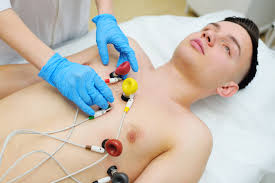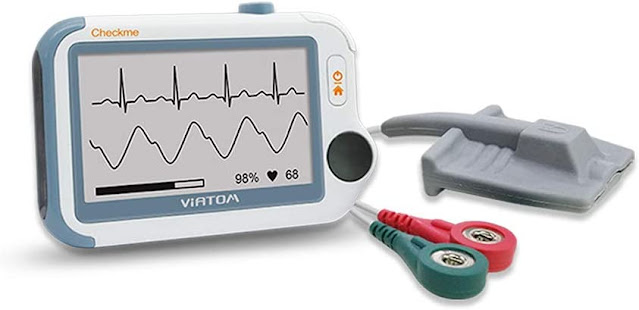What Is the Best Test To Check For Heart Problems?
Are you aware that your heart doesn't actually regulate your emotions—the organ you frequently and carelessly blame for your impulsive behaviours? In actuality, it enables the circulation of nutrients, oxygen, and blood throughout your body.
Each day, it beats more than 100,000 times, pumping 1.5 gallons of blood every minute. It maintains its hyperactivity so you may carry on. But do you adequately maintain the health of your heart? One of the new health problems in developing India is heart disease.
Lifestyle could be the cause. Don't let a sedentary lifestyle put you at risk for health issues. Let's start from the basics.
Your doctor might request a number of tests including an ECG test at home if you have heart problems or are suspected of having a heart ailment. Let's see the tests below.
Echocardiogram:
Creates
images of your heart using sound waves. Your doctor can observe how your heart
is pounding and how blood is flowing through it with this simple test. You can
also conduct the ECG test at home as
well. It is possible to spot a number of problems in the heart muscle and
valves using images from an echocardiography using an ECG device. You can perform this test either at rest or while
engaging in activity to raise your heart rate. If you have a portable ECG machine for home use then
it is quite simple for you to check your heart’s health.
Motives behind ECG test:
- Identify the origin of a cardiac murmur.
- Verify the heart valves' functionality.
- Evaluate the heart's general health
Transesophageal echocardiography (TEE):
Apart from
doing an ECG test at home, you can
create detailed images of your heart and the arteries that supply and exit it
using high-frequency sound waves (ultrasound). The oesophagus, which is located
very near the upper chambers of the heart, is connected to the echo transducer,
which generates the sound waves used in TEE, by a tiny tube that travels
through your mouth, throat, and oesophagus.
Motives behind TEE test:
- Evaluate the heart valves' performance.
- Investigate heart valve disease
- Look for heart-related blood clots.
Electrocardiogram (ECG or EKG):
Measures
heartbeat electrical activity and offers two different types of data. First, a
doctor can gauge how long the electrical wave takes to travel through your
heart by measuring time intervals on the ECG. The length of time it takes for a
wave to move from one region of the heart to the next reveals whether the
electrical activity is regular, slow, fast, or irregular.
Second, a cardiologist may be able to determine whether certain areas of the heart are too big or overworked by monitoring the amount of electrical activity flowing through your heart muscle.
Motives behind the ECG or EKG test:
- Track variations in heart rhythm
- Check to see if a heart attack has happened
- Help identify the risk of heart attack
Magnetic resonance imaging (MRI):
This technique
uses radiofrequency waves and a magnetic field to produce precise images of the
organs and other internal structures in your body. It can be used to check your
heart and blood arteries and find the parts of your brain that have experienced
a stroke.
Motives behind the MRI test:
- Analyse the heart's architecture
- Check the cardiac muscle for scar tissue.
- Evaluate the heart valves' performance.
CT scan:
A method of
X-ray imaging that creates cross-sectional images of your heart using a
computer. The procedure, also known as cardiac computed tomography, CAT scan,
or computerised axial tomography, can be performed to check your heart and
blood vessels for issues. Additionally, it is used to determine whether a
stroke has impacted brain blood arteries.
Motives behind the CT scan or test:
- Check the heart's architecture
- Ascertain whether the coronary arteries are blocked.
● Exercise Cardiac Stress test:
Also known
as an exercise tolerance test (ETT), this test determines whether your heart's
blood supply is adequate and whether your heart rhythm is normal while
exercising on a stationary bike or treadmill. Your level of exhaustion, heart
rate, respiration, blood pressure, and cardiac activity while exercising are
all tracked by the test. Combining this test with nuclear imaging or
echocardiography is an option.
Motives behind the Cardiac Stress test:
● Find the source of your chest pain,
weakness, and shortness of breath.
● Evaluate the heart's condition
● Evaluate the exercise's safety
● Recognize how your heartbeat alters
as you move around.
● Find indications that the cardiac muscle is not receiving enough blood during activity.
Treatments For Heart Diseases
Treatment for heart disease is based on the type and cause of heart damage. To be on a safer side, you can always opt for an ECG test at home. ECG machines that are portable could work in many ways. It helps in determining the cause quickly and without much hustles.
But, Healthy
lifestyle practises, including quitting smoking, exercising frequently, getting
enough sleep, and eating a low-fat, low-sodium diet, are crucial components of
treatment as well.
● Medications:
Medication may be required to
control heart disease symptoms and to avoid complications if lifestyle
modifications alone are ineffective. The kind of cardiac condition is what
determines the medicine kind.
● Procedures
such as surgery: Some
heart disease sufferers might require treatment or surgery. The type of heart
illness and the degree of cardiac damage will determine the sort of operation
or surgery.
● DIY remedies: Making some lifestyle modifications can help with heart disease, or possibly avoid it.
Ways To Enhance Heart Health
The following modifications are suggested to enhance heart health:
● Avoid
smoking: Smoking,
particularly atherosclerosis, increases the risk of heart disease. The greatest
method to lower your risk of heart disease and its complications is to stop
smoking. Ask your provider for assistance if you need it.
● Eat
nutritious foods:
Consume a lot of whole grains, fruits, and veggies. Cut back on salt, sugar,
and saturated fats. Serious health issues are more likely in people who have
uncontrolled high blood pressure. If you are 18 years of age or older, have
your blood pressure checked at least every two years.
● Exercise: You can acquire and keep a healthy
weight by engaging in physical activity. Diabetes, high cholesterol, and high
blood pressure are all risk factors for heart disease that can be managed with
regular exercise. Aim for 30 to 60 minutes of physical activity on most days of
the week with your doctor's approval. The type and quantity of exercise that is
appropriate for you should be discussed with your healthcare physician.
● Keep
a healthy weight: Heart
disease risk is increased by being overweight. To develop attainable objectives
for your weight and body mass index (BMI), speak with your healthcare
physician.
● Stress
management: Look
for strategies to lessen emotional stress. Some techniques for lowering and
managing stress include increasing physical activity, focusing on the present
moment, and participating in support groups.
Conclusion
Making healthy lifestyle choices, such as giving up smoking, eating a balanced diet, and increasing your physical activity, is never too early. The best defence against heart disease and its repercussions is a healthy lifestyle. Having said that, get an ECG device today to get answers to all your heart problems.


Comments
Post a Comment